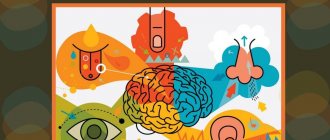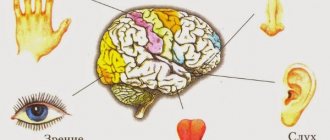Our clinic specializes in neurology and immunology. We have experienced specialists in related specialties - neurologists with additional training in immunology, dermatologists. The Clinic has equipment for studying the brain, sensory nerves and muscles.
- Numbness and decreased sensitivity
- Pain along the nerves
- Skin rashes due to nerve damage (shingles)
- Dizziness
- Increased sensitivity. Low pain threshold
- Mental changes. Nervous exhaustion. Asthenia. Depression. Psychosis
Numbness and decreased sensitivity
Numbness and decreased sensitivity are private companions of suffering in the nervous system. Decreased sensitivity and numbness occur for a specific reason: signals from the body's sensory receptors do not reach the brain or are not perceived by it. Why this happens can be found out during a neurological examination and through instrumental studies, incl. electroneuromyography and evoked potential studies. These neurophysiological studies test the entire sensory pathway, from the body's sensory receptors to the cerebral cortex. It is important to find the cause of the sensory disorder and confidently treat a specific and understandable disorder or disease.
To restore impaired sensitivity, in addition to treating the underlying disease, we will offer you magnetic stimulation. This treatment method makes recovery faster and easier. We recommend that you contact a neurologist to determine the cause of numbness and treatment.
Swing to the right: hemihypesthesia, parahypesthesia superior and inferior, hypoesthesia of one limb
Different diseases are characterized by different sensory disturbances (types of numbness). Possible causes of numbness or decreased sensitivity:
- Brain disease is characterized by impaired sensitivity or numbness of the extremities of the opposite half of the body: numbness of the right arm or leg when the left parts of the brain suffer, numbness of the left arm (leg) - the right.
- Spinal cord disease is characterized by impaired sensitivity below the site of injury, accompanied by tissue numbness.
- Polyneuropathy is characterized by sensory disturbances of the “gloves and socks” type.
- With a disease of one or another peripheral nerve, symptoms of numbness in the area of its innervation are characteristic: a feeling of numbness of the skin (including the head: facial skin, lips, tongue, etc.), numbness of the hand or fingers (fingertips, little finger, big toe), numbness of the foot.
Decreased sensitivity and numbness (as a symptom) in one or another part of the body may be associated with:
- With disruption of the conduction of nerve impulses from receptors that perceive sensations. This is possible when the receptors themselves die, the peripheral nerves, spinal cord or brain suffer;
- With the destruction of the area of the cerebral cortex that receives sensitive impulses.
More often we see a violation of all types of sensitivity at once, accompanied by partial or complete numbness of any part of the body. But only one or a few types of sensitivity may be affected. Thus, there may be a disturbance in the perception of only tactile, pain, temperature, joint-muscular sensations, sensations of pressure, movement, etc. This is typical for demyelinating diseases and polyneuropathy.
We will offer you treatment for numbness or decreased sensation based on our diagnostic findings.
Elimination of hypersensitivity in people with hearing impairments
Increased sensitivity to sounds in people with hearing impairments is corrected by an audiologist. In St. Petersburg, you can contact, where experienced specialists in this profile work.
Help involves selecting a specific assistive hearing aid that will suppress sound in a specific frequency range. The audiologist adjusts the system so that the frequency that causes the greatest discomfort is actively suppressed.
The phenomenon of accelerated increase in volume may not appear immediately, but rather after a while after fitting a hearing aid. In such a situation, you should not endure discomfort, but immediately go to a trusted specialist to purchase a new system or configure an old one.
To reduce the risk of developing an unpleasant condition, you should immediately contact a trusted hearing care center. If there are indications for installing a hearing system, you should not buy cheap devices without individual settings. The risk of increased sensitivity when wearing such a design is significantly higher. Audiologists will help you choose a design that is right for you and make its precise adjustment.
Pain along the nerves
Many diseases of the nervous system are accompanied by pain along the nerves. Neuralgia is often confused with musculotendinous pain in fibromyalgia. We have modern diagnostic equipment to determine the cause of pain along the nerves and experienced specialists to treat not only the pain, but also the symptoms. In particular, we perform electroneuromyography and ultrasound of the nerves.
Pain along the nerves (neuralgia) is most often caused by:
- pinched nerves,
- mono- and polyneuropathy,
- inflammation of the nerve trunks - polyneuritis.
The pain first appears at typical points where the nerves pass through narrow channels in the area of large joints near the tendons. Pain can only be felt when pressing on the points or appear spontaneously. In more severe cases, pain may occur along the nerves along the arms and legs.
Regardless of the cause of the pain along the nerve, we will find the cause, relieve you of the pain and prevent its further occurrence.
Typical places where pain appears along the nerves:
Occipital nerve; Trigeminal nerve
Brachial plexus and arm nerves; Intercostal nerves; Lumbosacral nerve plexus and leg nerves;
The source of pain along the nerve is usually easy to determine based on electroneuromyography and examination by a neurologist.
What diseases can be hidden behind?
Diagnosis of the condition in children and adults is the field of activity of psychoneurologists, clinical psychologists, and psychiatrists. The final diagnosis is made on the basis of a physical examination, interview, tests, assessment of the anxiety scale, study of life and clinical history.
An increase in the level of stress and anxiety should be differentiated from depressive states, maladjustment reactions, the initial stages of schizophrenia, as well as from other psychiatric diseases caused by the development of phobias, obsessive thoughts and conditions.
Skin rashes due to nerve damage (shingles)
Skin rashes with nerve damage are most often associated with viral aggression. The appearance of skin rashes indicates a decrease in the body's immune defense. Our task is to relieve you of skin rashes and improve the functioning of the immune system so as to stop the viral attack. Read more about the treatment of herpes zoster
Skin rashes with herpetic lesions of peripheral nerves (herpes zoster) appear on the skin in the area of the nerve affected by the virus.
Symptoms of herpes zoster:
- severe pain that gets worse when touching the skin,
- bubbles giving way to crusts,
- redness,
- severe itching is possible.
2. Isomerization reaction with thermal activation
The previous section talked about the isomerization of retinal upon absorption of a light quantum (that is, this is an elementary act of vision). But what about temperature activation leading to “dark noise” of rhodopsin?
We tried to apply the QM/MM method to this problem as well, in order to follow the elementary event of rhodopsin activation not by light, but by elevated temperature. For this purpose, a study of the intermediate state between rhodopsin and bathrodopsin was carried out. Analysis of the vibrational structure of the spectrum shows that it is characterized by the presence of one imaginary frequency (283i cm−1), corresponding to vibrations in the region of the isomerizing double bond (Fig. 8).
Figure 8. Vibration shape corresponding to the imaginary vibration frequency 283i cm−1 in the transition state
A feature of the geometric configuration of the transition state is the almost straight dihedral angles C10-C11=C12-C13 and H-C11=C12-H and the changed bond order (that is, the isomerizing bond can actually be considered a single bond). Such signs indicate the possibility of a biradical nature of the transition state.
Within the framework of the unrestricted Hartree-Fock method, orbitals were obtained, the peculiarity of which is that almost all orbitals of the conjugated π-system are localized on one side of the C11=C12 bond (either on the side of the β-ionone ring or on the side of the protonated Schiff base). Using this approximation as a starting one for calculating CASSCF showed that the dominant one in the ground state is the CSF, in which 10 electrons are paired in the 5 lower orbitals of the active space, and the remaining two are paired and occupy spatially separated orbitals (Fig. 9).
Figure 9. Singly occupied orbitals in the transition state structure
The summation of the Mulliken charges showed that in such a structure there is no transfer of positive charge towards the β-ionone ring, that is, the formation of a single C11-C12 bond from a double bond occurs through homolytic cleavage of the double bond. The result of calculating the spin density confirms the assumption of a biradical character.
To study isomerization, a singlet biradical solution was constructed in which two unpaired electrons were in spatially separated orbitals (similar to Fig. 9). The energy barrier of the isomerization reaction on the surface of the ground electronic state is 26 kcal/mol, and the true activation energy, taking into account the difference in the energies of zero-point vibrations of the reagent and the activated complex, is 23 kcal/mol. This result is in good agreement with the results obtained in the experiment (20–25 kcal/mol).
From the resulting transition state, a vibrational mode corresponding to a single imaginary frequency was descended, followed by energy minimization. The geometric configuration of the stationary point obtained in this way coincides with the equilibrium geometric configuration obtained by optimizing the geometric parameters of the SAR structure. Thus, the primary stable intermediate of the photoinduced and thermally activated process coincides.
When comparing the calculated and experimental enthalpies of the rhodopsin → batorhodopsin transition, we have already discussed the shortcomings of the experiment and its inconsistency with the results obtained in similar systems. Now these arguments are supplemented by data obtained from studying the reaction during thermal activation. If it is known that the true activation energy is 23 kcal/mol, then the product, that is, batorhodopsin, cannot lie above rhodopsin by 32 kcal/mol, that is, 6–9 kcal/mol above the transition state of the thermal reaction (Fig. 10) .
Figure 10. Scheme of a photoinduced reaction (dashed line) and a reaction during thermal activation in the ground electronic state (solid line)
* * *
To summarize, detailed information has been obtained on the structure and properties of rhodopsin and bathrodopsin. The cis-trans isomerization reaction during thermal activation in the ground electronic state was also characterized and it was established for the first time that the primary intermediate of both the photoinduced and thermally activated reactions is batorhodopsin. All these results were obtained based on the analysis of structures only in the ground electronic state, as well as from the calculation of spectral properties and consideration of the features of electronic configurations at stationary points. This method of studying has proven itself for such a well-studied system as rhodopsin and has allowed us to obtain a number of new results, in particular regarding the cis-trans isomerization reaction that underlies our vision.
Dizziness
These symptoms occur when organs that provide balance suffer (inner ear, cochleovestibular nerve, brain stem, cerebellum) and are often accompanied by nausea and vomiting. The appearance of dizziness and unsteadiness indicates the inability of the nervous system to correctly navigate in space and maintain the body’s center of gravity within the area of support. Hence the risk of falling.
Damage to the inner ear and cochleovestibular (auditory and vestibular) nerve or vestibular ataxia is accompanied by severe dizziness with a feeling of spinning, nausea and vomiting. This kind of dizziness is called systemic. Typically, dizziness increases after changing body position (standing or lying down), turning or tilting the head. The inner ear and cochleovestibular nerve often suffer from neuroinfections and inflammatory processes in the throat and paranasal sinuses. It is also possible to experience hearing loss similar to sensorineural hearing loss.
Damage to the cerebellum (cerebellar ataxia) , in addition to systemic dizziness, is often manifested by intention tremor , i.e. trembling of the arms and legs when trying to make an accurate movement, when approaching the target (for example, when hitting a lock with a key). Usually we have to deal with damage to the cerebellum in multiple sclerosis, chronic alcohol intoxication and cerebrovascular accident. In the case of vascular disorders, the picture may be complemented by transient or permanent visual impairment due to the commonality of the cerebellar circulatory system and the visual cortex.
Balance imbalance due to sensitivity disorder (sensitive ataxia) occurs due to a deficiency of information signals coming from sensory receptors of muscles and joints. In this case, the brain is not provided with complete data about the spatial position of various parts of the body, hence the disorder of balance and coordination of movements. Sensitive ataxia is a typical symptom of polyneuropathy. A characteristic sign is unsteadiness to the point of falling with the eyes closed or in the dark, when it is difficult to use vision for spatial coordination.
Frontal ataxia (gait ataxia) occurs when the anterior parts of the cerebral hemispheres are damaged and is manifested by a loss of walking skill in the absence of systemic dizziness and with preserved strength in the legs. This is possible with neuroinfections, multiple sclerosis, circulatory disorders, tumors, alcoholism and other diseases.
The basis of treatment for dizziness and balance disorders is the correct identification of the cause and its elimination. Therefore, treatment in our clinic will begin with clarifying the cause of what is happening . In most cases, dizziness and unsteadiness can be significantly reduced or eliminated altogether.
Causes of hyperacusis
Increased sensitivity to sounds is a fairly common problem, but the exact causes of its occurrence are still being studied. Hyperacusis can be unilateral or bilateral, constant or intermittent. A person may have difficulty tolerating specific sounds or any loud noises. People of any age are susceptible to the disease, including young children.
Risk factors for developing the problem:
- Meniere's disease;
- traumatic brain injuries;
- past infectious diseases;
- some mental and neurological disorders;
- vascular diseases;
- brain tumors;
- inflammation of the ear of exudative type;
- autism;
- long-term daily or professional exposure to noise on the body;
- long-term use of certain medications;
- diseases of the temporomandibular joint;
- genetic defects;
- Lyme disease;
- age-related changes in the hearing aid.
The phenomenon of hyperacusis, characteristic of people with impaired hearing, develops only with bilateral lesions. If hearing loss bothers only one side, then compensatory mechanisms cope on their own.
Mental changes. Nervous exhaustion. Asthenia. Depression. Psychosis
Depression and asthenia are frequent companions and a supporting factor in many chronic diseases. They are caused not just by a decrease in mood, but also by a biochemical imbalance of the central nervous system, incl. disorganization of the serotonin systems of the brain. A kind of vicious circle “illness-depression-illness” is formed. In most cases, a good treatment result is based on working with this vicious circle, i.e. on the treatment of the underlying disease and restoration of regulatory processes in the nervous system, incl. and serotonin regulation.
Under the influence of antidepressant treatment, immunity indicators and blood biochemistry, blood pressure, ECG, EEG change for the better, and sleep improves. The restoration of lost movement functions occurs faster, and spasticity also decreases.
Reasons for mental changes
There are several main reasons for depression in diseases of the nervous system:
- Immune and infectious aggression against the nervous system;
- Prolonged stress caused by illness;
- Long-term unpleasant symptoms (pain, weakness, etc.);
- Unpleasant medical procedures;
- Cerebrovascular accident;
- Forced change in lifestyle;
- Side effects of certain medications (for example, interferons).
Symptoms of mental changes
Personality change. The development of personality changes can be found in almost any brain disease. It is characterized by a sharpening (strengthening) of some personal characteristics to the detriment of others or the appearance of pathological personality traits. Thus, pathological aggressiveness, greed, suspicion, negativism and depression, euphoria, a pathological tendency to flat jokes, hypo- or hypersexuality, neglect of hygiene, excessive religiosity, etc. may appear. The ability to adequately assess one’s own actions decreases, hence conflicts with other people and troubles with the law. With a long course of the disorder, especially in the absence of treatment, a decrease in intelligence is possible.
Psychosis. In the long-term period of traumatic, infectious and intoxication diseases that cause the death of brain cells, periodic organic psychoses may develop. Often psychoses occur at regular intervals (sometimes they have a clear seasonality).
Possible symptoms:
- Twilight stupefaction with excitement;
- Hallucinations;
- Rave;
- Insomnia;
- Autonomic disorders (changes in blood pressure, body temperature, menstrual cycle, etc.).
Treatment of personality disorders
We recommend seeking help if you experience symptoms of a personality disorder. In our clinic, treatment is carried out in several directions at once:
- Preventing the death of brain matter. In addition to treating the underlying disease, nootropic drugs, antioxidants, and polypeptide drugs are used.
- Relief of depression and agitation, sleep disorders. Here, mainly nootropics with a calming effect, antidepressants and antipsychotics are used, in the correct combination that preserves normal vital functions.
- Working with a psychotherapist to understand and correct social and personal problems.
What is increased anxiety?
Increased anxiety is a person’s high sensitivity to anxiety and stressful life situations. The condition is more often registered in children of preschool and high school age, as well as in women with psycho-emotional instability, concomitant neurological diseases, and mental childhood trauma.
A slight increase in a person’s stress level is considered as an individual personality trait, as a feature. If stress becomes intrusive and worsens the quality of life of the patient or others, then they speak of mental pathology. The prevalence of the disease among other affective disorders is 33%, 25% occurs in childhood.
Literature
- MG Khrenova, AV Bochenkova, AV Nemukhin. (2009). Modeling reaction routes from rhodopsin to bathorhodopsin. Proteins
.
78 , 614–622; - Feldman T.B., Kholmurodov Kh.T., Ostrovsky M.A., Khrenova M.G., Nemukhin A.V. (2009). Study of the conformational state of the chromophore group, 11-cis-retinal, in rhodopsin using computer molecular modeling methods. "Biophysics". 54, 660–667;
- Khrenova MG, Bochenkova AV, Nemukhin AV Theoretical characterization of bathorhodopsin. In: Molecular simulation in materials and research biological / ed. by Kh.T. Kholmurodov. Nova Science Publishers, 2009. P. 19–27;
- Nobel Prize in Chemistry (2012): for the receptors of our first, third and fourth senses;
- Visual rhodopsin is a receptor that responds to light;
- Receptors in active form;
- The triumph of computer methods: prediction of protein structure;
- Molecular dynamics of biomolecules. Part I. History of half a century ago.










